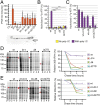Severe viral respiratory infections in children with IFIH1 loss-of-function mutations
- PMID: 28716935
- PMCID: PMC5547624
- DOI: 10.1073/pnas.1704259114
Severe viral respiratory infections in children with IFIH1 loss-of-function mutations
Abstract
Viral respiratory infections are usually mild and self-limiting; still they exceptionally result in life-threatening infections in previously healthy children. To investigate a potential genetic cause, we recruited 120 previously healthy children requiring support in intensive care because of a severe illness caused by a respiratory virus. Using exome and transcriptome sequencing, we identified and characterized three rare loss-of-function variants in IFIH1, which encodes an RIG-I-like receptor involved in the sensing of viral RNA. Functional testing of the variants IFIH1 alleles demonstrated that the resulting proteins are unable to induce IFN-β, are intrinsically less stable than wild-type IFIH1, and lack ATPase activity. In vitro assays showed that IFIH1 effectively restricts replication of human respiratory syncytial virus and rhinoviruses. We conclude that IFIH1 deficiency causes a primary immunodeficiency manifested in extreme susceptibility to common respiratory RNA viruses.
Keywords: IFIH1; RIG-I-like receptor family; respiratory syncytial virus; rhinovirus; severe pediatric infectious disease.
Conflict of interest statement
The authors declare no conflict of interest.
Figures



References
Publication types
MeSH terms
Substances
LinkOut - more resources
Full Text Sources
Other Literature Sources
Medical

